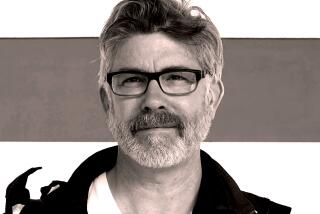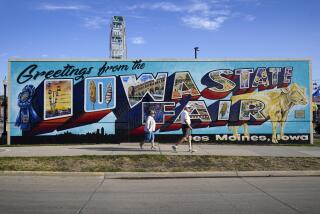No Nouvelle Food for These Folk
- Share via
How can you tell if you’re a genuine Midwesterner? Easy: You can recite the names of the men on Mount Rushmore, you eat “dinner” at noon, you know a pesticide from a herbicide, and when you hear the word “stock,” you think of cattle, not Wall Street.
These are a few of the thousands of traits, quirks and endearments that make Midwesterners different from the rest of the country, writes Carolyn Lieberg of Iowa City, Iowa, who has chronicled her home territory in “Calling the Midwest Home” (Wildcat Canyon Press, 1996).
It’s a lighthearted salute to the earnest folks (19.6% of the country’s population in 13 states) dismissed in trendy Los Angeles and New York as “flyover people.” Lieberg combines history, myth and personal essays to profile the nation’s heartland, where neighbors still help each other in a crisis and people are so honest they’re allowed to pump the gas before they pay for it. Some samples:
On Endurance:
Nineteenth century Europeans seeking opportunity traveled by steerage, then covered wagon to settle the frontier where they farmed, made their own candles, soap, maple sugar and clothes. That produced the famous Midwestern work ethic.
On Meteorological Endurance:
The element most shaping Midwest durability is weather. Not only do the character-building seasons range from sweltering August to snow-crunching January, those patterns are interrupted by the excesses and deprivations of floods, tornadoes, blizzards, ice storms and drought.
On Eats:
At a typical Midwestern table, some basic foods dominate, including cream, sugar, beef, potatoes, pork, pies, puddings, cakes, pickles and preserves. No exotic spices or nouvelle anything. Salt and pepper hold sway. All foods are identifiable, with the exception of the contents of a pudding. Mealtime traditionally was so serious that the lumber camps in Michigan posted a sign: “No talking at the table.”
On Sports:
The football huddle was introduced by Robert Zuppke (German-born and Wisconsin-raised) when he coached at the University of Illinois. George Hancock of Chicago thought of softball in 1887 as an indoor alternative to baseball during the winter. Today, anybody who sees a couple wearing red and white walking toward a stadium knows that Nebraska is playing.
On Education:
The Midwest has 599 colleges and universities including the first land grant college, the first dental school and the first journalism school.
On the Midwestern Bill of Rights:
“As Midwesterners we reserve the right to tune into the Weather Channel 24 hours a day, consume a meal that is entirely composed of pale food, perform actual work wearing Oshkosh bibs, conduct a meaningful conversation using only shrugs and grunts, and mow our own lawns even if we can afford to hire someone else to do it. . . .”
More to Read
Sign up for The Wild
We’ll help you find the best places to hike, bike and run, as well as the perfect silent spots for meditation and yoga.
You may occasionally receive promotional content from the Los Angeles Times.






